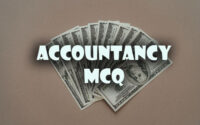Commerce Related Questions and Answers
1. Policies involved when managers repeatedly make some decisions in similar situations over a period of time are
(A) specific policies
(B) express policies
(C) implied policies
(D) appealed policies
2. Visual representation of organization structure is known as
(A) organization system
(B) organization chart
(C) organization pattern
(D) line organization
3. Workload analysis, workforce analysis and comparison thereof are the essential steps of
(A) Recruitment
(B) Selection
(C) training and development
(D) manpower requirement
4. Motivation, leadership and communication are the three main components of
(A) Supervision
(B) goal-setting process
(C) direction
(D) HR management
5. The expectation theory of motivation was developed by
(A) Victor H. Vroom
(B) J. Stacy Adams
(C) Clayton Alderfer
(D) B. F. Skinner
6. Cognitive theory of motivation is based on
(A) Need
(B) Perception
(C) Behaviour
(D) reinforcement
7. Control that chooses the best inputs to avoid defective outputs is known as
(A) feedback control
(B) concurrent control
(C) feedforward control
(D) strategic control
8. Tactical level controls are exercised by
(A) middle-level managers
(B) lower-level managers
(C) top-level managers
(D) managers at all levels
9. The relationship between a superior and his immediate subordinate is
(A) direct relationship
(B) cross-relationship
(C) group relationship
(D) indirect relationship
10. Authority flows from leaders to followers in
(A) formal organization
(B) informal organization
(C) divisional organization
(D) both formal organization and informal organization
11. Classical theory of organization focuses on
(A) Work
(B) People
(C) System
(D) administration
12. Teamwork has no place in
(A) committee organization
(B) project organization
(C) matrix organization
(D) virtual organization
13. Dual accountability violates the principle of
(A) unity of command
(B) discipline
(C) responsibility
(D) order
14. The concept of ‘leaming organization’ is introduced by
(A) Tom Peters
(B) Michael Porter
(C) Peter Senge
(D) C. K. Prahlad
15. Delegation to subordinate in the same level is called
(A) vertical delegation
(B) overlapping delegation
(C) lateral organization
(D) direct delegation
16. The first secretary of a company is appointed by the
(A) promoters of a company
(B) board of directors
(C) shareholders
(D) central government
17. In case of a private company, the maximum number of members as per the Companies Act, 2013 is restricted to
(A) 50
(B) 100
(C) 150
(D) 200
18. The statement which is not included as Financial Statement of a company as per the Companies Act, 2013 is
(A) Cash Flow Statement
(B) Fund Flow Statement
(C) Balance Sheet
(D) Statement of Changes in Equity
19. Equity shares issued by a company to its directors and employees who have provided their know-how or have contributed in intellectual property rights or value addition are known as
(A) rights shares
(B) sweat equity shares
(C) privileged equity shares
(D) sugar-coated shares
20. The market price of a mutual fund unit is not a function of
(A) net asset value
(B) life of the fund
(C) market sentiment
(D) investors’ sentiment
| Model Question | Old Question |
| Sample Papers | Mock Test |
| Practice Set | Question Bank |
21. OTCEI was established in the year
(A) 1992
(B) 1987
(C) 1990
(D) 1994
22. Trade association is a form of
(A) simple combination
(B) compound combination
(C) mixed combination
(D) parallel combination
23. Payments in NSEI are to be settled within
(A) 10 days
(B) 15 days
(C) 7 days
(D) 30 days
24. Which scheme is introduced by the Government for market and commodity research and participation in trade fairs and exhibitions?
(A) Market Development Assistance
(B) Market Access Initiative
(C) Cash Compensating Support
(D) Export Promotion Assistance
25. Trademark Account is a
(A) personal account
(B) real account
(C) nominal account
(D) deferred asset account
26. What is meant by pro-rata allotment of shares?
(A) Allotment of shares in certain proportion
(B) Rejection of some applications and rest are allotted in full
(C) Proportionate allotment to promoters and other applicants
(D) All applicants are allotted shares in equal numbers
27. Which is not the internal cause of depreciation?
(A) Wear and tear
(B) Exhaustion
(C) Obsolescence
(D) Overwork
28. SEBI was established to regulate
(A) money market
(B) capital market of shares only
(C) securities market
(D) company administration
29. Trade Receivables include
(A) Trade Debtors
(B) Bills Receivables and Suppliers
(C) Trade Debtors and Suppliers
(D) Trade Debtors and Bills Receivables
30. Issue of Bonus Shares is a process of
(A) attracting more investors in shares
(B) capitalization of profits
(C) employee motivation
(D) distribution of gift to officers
31. Trading on Equity’ means
(A) doing business with equity shares only
(B) selling of equity shares privately
(C) share trading in Stock Exchanges
(D) use of debt capital with equity capital in capital structure
32. The Article of Association of a company may be altered by passing
(A) ordinary resolution
(B) special resolution
(C) general resolution with the consent of creditors
(D) bill in the parliament
33. According to ‘Du Pont Triangle’, profit is a function of
(A) price and quantity
(B) cost and investment
(C) sales and cost
(D) sales and assets
34. The type of market where single seller dominates the entire market is referred to as
(A) Perfect
(B) Imperfect
(C) Local
(D) global
35. Working capital management basically aims at striking balance between
(A) debtors and creditors only
(B) long-term fund and short-term fund
(C) profitability and liquidity
(D) fixed assets and current assets
36. Watered capital means
(A) Overcapitalization
(B) Undercapitalization
(C) excess equity capital
(D) part of the capital not represented by assets
37. Overdraft is a short-term financial instrument to
(A) pay taxes
(B) repay loan
(C) redeem debentures only
(D) meet working capital requirement
38. Sole-trading business is subject to the
(A) general laws of the land
(B) MRTP Act
(C) One-Contract Act
(D) Negotiable Instrument Act
39. ‘Par value’ can also be named as
(A) face value
(B) redemption value
(C) market value
(D) realizable value
40. Motivation is important to managers, because
(A) it is a significant contributor to high performance
(B) it does not explain the differences in intensity of behaviour
(C) it explains the differences in attitude and personality
(D) not all employees know how to use it effectively
41. Organizational design is based on decisions about
(A) work specialization and mechanisms
(B) chain of command and span of control
(C) centralization and matrices
(D) strategy and structure
42. Parallel integration of business units is known as
(A) vertical combination
(B) horizontal combination
(C) lateral combination
(D) diagonal combination
43. Which of the following is/are public documents of a company?
(A) Books and Accounts
(B) Registers
(C) Certificate of Incorporation
(D) Memorandum and Articles
44. A company secretary is
(A) a member of the company
(B) a creditor of the company
(C) a custodian of the company
(D) an officer of the company
45. Cumulative Preference Shareholders can claim unpaid dividend of earlier years as a matter of right, only when
(A) there are sufficient profits
(B) company goes into winding-up
(C) there are sufficient liquid funds
(D) directors refuse to pay despite available cash balance
46. The main objective of controlling is to
(A) punish the guilty person
(B) ensure that performance is as per planning
(C) maintain discipline
(D) fix responsibility of subordinates
47. The subsidiary voucher produced in the absence of primary voucher is called
(A) general voucher
(B) collateral voucher
(C) notebook voucher
(D) counterfoil
48. The statutory report of a company is prepared by the
(A) shareholders in general meeting
(B) registrars
(C) secretary
(D) directors
49. The balance of which of the following items may have credit balance too?
(A) Cash
(B) Bank
(C) Investment
(D) Stock
50. A and B are two partners in a firm. They admit C giving him one-fourth share in future profits. The new profit-sharing ratio of these partners will be
(A) 1:1:4
(B) 3:1:2
(C) 3:3:2
(D) 3:3:4


